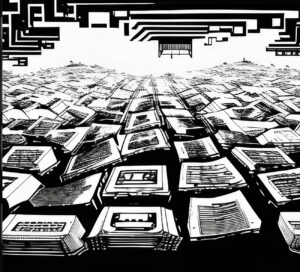What Are CCO NFTs, And How Do We Implement Them ?
The market was flooded with numerous digital creations, with different designs, attributes, and characters, during the PFP (profile picture) hype last year, which raised the awareness of speculators and the public and dubbed the NFT summer. The first utility of NFT collections, though not stated literally but shared in common, is the intellectual property (IP), the IP rights of the NFT collection for its holders.
The first ‘Value’ of NFT
Famous collections like Bored Ape Yacht Club(BAYC) are known for allowing their holders to use their BAYC NFTs for business purposes, granting them commercial rights over their NFTs. The team behind the BAYC collection Yuga Labs still keeps the rights to use the collection name of BAYC and the collection logo, but for the 10,000 NFTs, their commercial rights all belong to their respective holders. Holders could earn profits with licensing deals to license their NFTs or build with their NFT’s IP.
Such acts unlock the creativity of holders, from secondary creations to physical merchandise, restaurants, and products with the BAYC as their theme. The allowance of business rights helps leverage community power to bring values back to the collection, which increases the collection’s influence and price value.
And so, most of the new collections follow the same path, treating it as one of the requirements or strategies to become the next big collection. However, such ‘value,’ the IP value, depends on the collection’s popularity, which turns into a chicken or egg dilemma. The market soon lost interest in the magic of business rights until the first used CC0 standards.
CC0 NFT project
A CC0 NFT project allows the NFTs to be used commercially without attributing them to the original creator. This solves the copyright issues in the NFT world and encourages the community behind the NFTs to adapt it to other forms of content, which adds value to the content. Popular adoption forms include derivative collections, memes, secondary creations, etc.
The pioneer projects that taught the NFT world the significance of the CC0 licensing model are the “Nouns’’ and “Mfers” projects, which demonstrated how community power could lead to the success of collections, as NFT projects are valued with their community activity and engagement. The licensing model was then soon followed by many other NFT projects, including CrypToadz, CryptoDickButts, Goblintown.wtf, Rektguy.
Derivative NFT collections are one of the popular subsequences of adopting CC0, allowing holders to own a similar collection at a lower price without worrying about copyright and IP issues. This also increases the brand outreach of the parent collection. Mfers collection would be a good example, where you can find more than 20 derivative Mfers collections in the market.
The downside
CC0 might look like a new must-include standard, looking back at the CC0 summer at the start of 2022’s summer. Still, CC0 is more like the direction and strategy a collection would like to adopt, as there are some downsides.
CC0 gives power to the community, and the collection is rewarded with influences from them, reflected in the increase in market value due to popularity. However, such benefits are at the cost of the NFT holders.
Loss of exclusivity
Moonbirds is another famous collection in the space, and its commercial rights originally belonged to its holders in the beginning. It is the BAYC path, where holders could benefit from licensing the use of their NFT to businesses, brands, and creative initiatives. However, the Moonbirds team then decided to go down the CC0 route to follow the trend, which made some holders unhappy.
From the holders’ perspective, some were working on licensing deals with their owned NFTs, which is also a monetary reason backing the market price of the collection. But after the sudden CC0 decision, their holders lost their exclusivity, where businesses, brands, and other individuals can use the IP for free. The standard lowers the incentives for holders to build on top of their NFTs to a certain degree, reducing the intrinsic value of the NFT itself.
Risk to image and reputation
Everyone grants the right to create with attributes from CC0 projects, which may have risks if some groups use the CC0 image related to violence or political context. This can turn into a viral meme, damaging the image of the collection, and the reputation of the artists and creators.
Pepe the Frog is an excellent example of such a case. Originally an apolitical character, Pepe was appropriated from 2015 to 2016 onward as a symbol of the alt-right movement. It was included as a hate symbol, and its creator was affected. So it might be a strong argument where it might make sense to hold on to your IP rights, as the collection can control the narrative.
Implementations
It is the collection and creators’ decision whether they should go for CC0 or not. It better be decided before launch, as the exclusivity of commercial rights would be counted in the price of NFT.
New standards
In August 2022, a16z introduced a new set of NFT license standards based on the CC0 standard to allow creators to clearly state the respective rights of the NFT to both the creators and holders in the future. With such a clear definition of rights included, both parties, the creators and owners, could be sure about the benefits and limitations they are granted with.
New minting features
Old NFT collections display their rights and adoption of licensing with their collection info pages and social media. Still, they are not coded into the smart contracts on-chain. Without a clear definition, users will need to make an extra effort to research license status before purchasing.
A new minting feature allowing the upload of license contracts during minting is required to adopt such changes. As the license is uploaded fully on-chain, potential buyers could easily acknowledge the license status of NFT. It also can be easy to understand the full definition of licensing rights with the full copy uploaded on-chain. This acts as a protection to both the creator and buyers, settling conflicts or issues based on the clearly stated rights on-chain.
Final thoughts
NFT as a tool is evolving and growing to support complex needs. The clarification of responsibility and rights could eliminate risks, offer protection for users adopting the product, and encourage adoption to potential users, as they are safe to use. The more comfortable and safe the product to use, the more creativity and potential unlock from worry and danger. We are building a better future for the good of the people.





